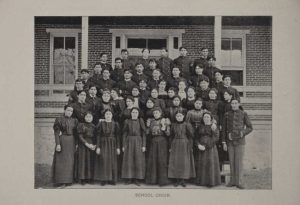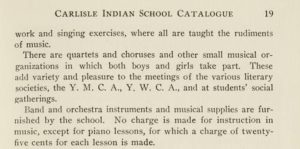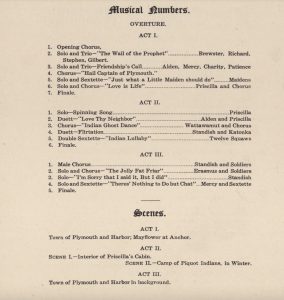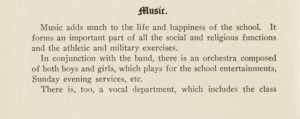
United States Indian Industrial School. 1895-1900. United States Indian industrial school, Carlisle, Pennsylvania. Available through: Adam Matthew, Marlborough, American Indian Histories and Cultures, http://www.aihc.amdigital.co.uk/Documents/Details/Ayer_E97_6_C2_C45 [Accessed November 02, 2021].
In 1879, Carlisle Indian Industrial School was the first government run boarding school for Native Americans to open. Carlisle was known nationally for their extracurriculars such as their band and football team. Like the academic classroom settings, these extracurriculars were centered around promoting American ideals1. For example, students put on a performance of, “The Captain of Plymouth,” an opera that celebrates the white settlers’ arrival to America.
Students played and celebrated their white colonizers in this play and had to perform songs such as, “Hail Captain of Plymouth” and “Indian Lullaby”.
Students at Carlisle were required to take music classes and were taught exclusively Western Classical music. Music was used to enhance the Christian teachings forced on the students as the orchestra and band played for evening Sunday services. Even in the course description of their music offerings, Carlisle makes it clear that there is only one way to make music. The white way.

Carlisle Indian Industrial School. 1915. Catalogue and synopsis of courses, United States Indian School, Carlisle, Pennsylvania. Carlisle: Carlisle Indian Press. Available through: Adam Matthew, Marlborough, American Indian Histories and Cultures, http://www.aihc.amdigital.co.uk/Documents/Details/Ayer_389_C2_C2_1915 [Accessed October 31, 2021].
“There is, too, a vocal department, which includes the class work and singing exercises, where all are taught the rudiments of music”
The phrasing, “the rudiments of music” implies that there is only one way to make music, and the way students made music at home was incorrect. Furthering the assimilation practices, the course catalogue encourages western music to be made at “student social gatherings.”
Indigenous people are still impacted from the trauma these boarding schools and white colonizers inflicted upon them. Better understanding the harmful effects western classical music had on Native Americans can steer us in the right direction towards healing.


